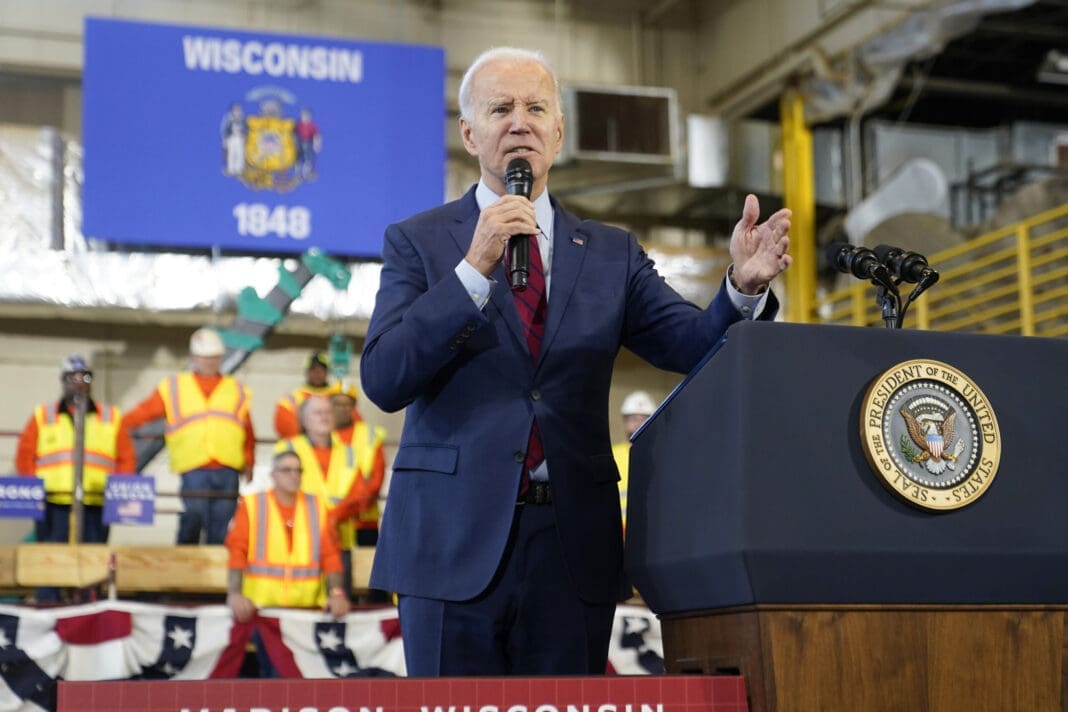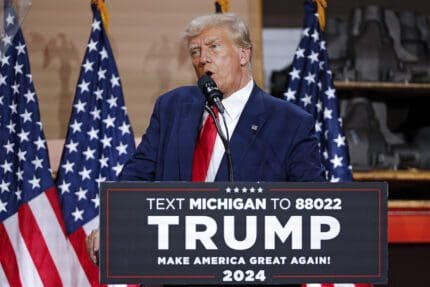Biden attends groundbreaking for Intel factory in Ohio projected to create 20,000 jobs
The CHIPS and Science Act provides subsidies to companies to manufacture semiconductors in the United States.

President Joe Biden on Sept. 9 attended the groundbreaking of Intel’s new $20 billion plant in Columbus, Ohio, which is expected to bring as many as 20,000 jobs to the state.
The groundbreaking follows Biden’s signing on Aug. 9 of the CHIPS and Science Act, which provides $52 billion in subsidies to companies to manufacture semiconductors in the United States, along with billions more for investment in research and development of technologies.
The legislation passed Congress under Democratic leadership, with a majority of Republicans in the House and Senate voting against it. House Minority Leader Kevin McCarthy led a failed attempt to kill the bill.
At the event, Biden made the connection between his policies and decisions by corporations to bring manufacturing to the United States:
Folks, we need to make these chips right here in America to bring down everyday costs and create good jobs. Don’t take my word for it — you heard [Intel CEO] Pat [Gelsinger]. Listen to the business leaders across this country who are making decisions right now about where to invest and produce these chips. China? Japan? South Korea? European Union? All these places are investing tens of billions of dollars to attract chip manufacturers to their countries. But industry leaders are choosing us, the United States, because they see America is back and America is leading the way.
Intel, a multinational corporation that manufactures semiconductor chips, announced its intention to build the facility in what it calls the “Silicon Heartland” in January. The company has projected that when it opens, the plant will permanently employ 3,000 people with an average salary of $135,000 a year. It also said it believes that the project will generate 7,000 construction jobs in Ohio as well as another 10,000 jobs indirectly related to the plant.
Intel said in a press release that the site can accommodate as many as eight chip fabrication factories and that the company will have invested $100 billion in the project by the time construction is completed over the next decade, “making it one of the largest semiconductor manufacturing sites in the world.”
On March 1, in his first State of the Union address, Biden called on Congress to pass the CHIPS and Science Act, then under consideration. He specifically cited Intel’s planned Ohio facility, describing it as a “field of dreams” where “America’s future will be built.”
In June, Intel warned that construction could be delayed and the project scaled back if the legislation did not pass.
When the bill passed Congress, Republican Ohio Gov. Mike DeWine praised it and highlighted its importance for his state.
“This $52 billion investment to domestically produce semiconductor chips on American soil will strengthen our national security, help fuel economic growth, and turn Ohio into a nationwide semiconductor powerhouse,” he said in a statement. “As Intel begins construction in Licking County to bring its most advanced semiconductor manufacturing facilities to our state, Ohio is on its way to becoming an indispensable player in the semiconductor industry.”
Pat Tiberi, a former Republican U.S. representative and currently the president and CEO of the lobbying group Ohio Business Roundtable, said he expects that the plant will help to attract other companies to the region. He told Columbus NBC affiliate WCMH-TV in July, “Next month here in central Ohio, 40 plus suppliers, other business who aren’t located in Ohio, are going to come here to look where they can put their facility to help the Intel supply chain.”
Intel has also said it will invest $50 million in Ohio’s education system over 10 years. On Sept. 9, the company announced that as part of its Ohio Semiconductor Education and Research Program, it will give $17.7 million over the next three years for eight semiconductor research projects at 80 colleges and universities in Ohio.
The CHIPS and Science Act is aimed at spurring competition with countries like China, which has for years spent public funds to subsidize its domestic chip manufacturing industry. The Washington Post reported in 2021 that China is projected to spend as much as $200 billion on semiconductor companies through 2025.
Over the last 30 years, America has lost its lead in semiconductor manufacturing, dropping from 37% of global manufacturing capacity in 1990 to 12% in 2021. By contrast, China went from essentially zero in the late 1990s to what is projected to be 24% in the next 10 years.
As part of the Biden administration’s focus on U.S.-based manufacturing, the administration in November reportedly dissuaded Intel from taking over the operation of a chip production plant in Chengdu, China.
Intel CEO Patrick Gelsinger has said that subsidies like those contained in the CHIPS and Science Act have made it possible for companies like his to invest in U.S.-based manufacturing instead.
Since the bill became law, other companies have announced billions of dollars in future investments in American facilities.
Micron Technology said it would spend $40 billion over a decade on domestic memory manufacturing, while Qualcomm said it would increase its order for semiconductor chips from U.S.-based GlobalFoundries to a total of $7.4 billion through 2028.
Published with permission of The American Independent Foundation.
Recommended

Biden calls for expanded child tax credit, taxes on wealthy in $7.2 trillion budget plan
President Joe Biden released his budget request for the upcoming fiscal year Monday, calling on Congress to stick to the spending agreement brokered last year and to revamp tax laws so that the “wealthy pay their fair share.”
By Jennifer Shutt, States Newsroom - March 11, 2024
December jobs report: Wages up, hiring steady as job market ends year strong
Friday’s jobs data showed a strong, resilient U.S. labor market with wages outpacing inflation — welcome news for Americans hoping to have more purchasing power in 2024.
By Casey Quinlan - January 05, 2024
Biden’s infrastructure law is boosting Nevada’s economy. Sam Brown opposed it.
The Nevada Republican U.S. Senate hopeful also spoke out against a rail project projected to create thousands of union jobs
By Jesse Valentine - November 15, 2023









































































